Lessico
Calcedonio
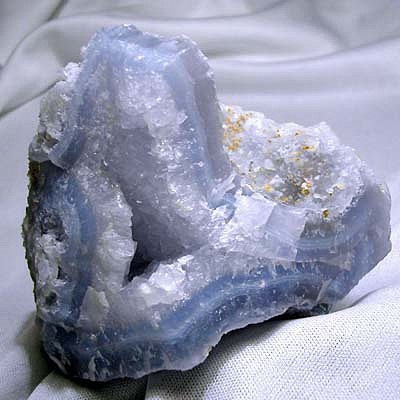
Il nome
del calcedonio deriva dal greco chalkŰdˇnios,
di Calcedonia (antica cittÓ dell'Asia Minore, nella Bitinia![]() ,
sulla costa asiatica del Bosforo, nel luogo dell'odierna Kadik÷y, sobborgo di
Scutari o ▄skŘdar, questa a sua volta considerata sobborgo
asiatico di Istanbul).
,
sulla costa asiatica del Bosforo, nel luogo dell'odierna Kadik÷y, sobborgo di
Scutari o ▄skŘdar, questa a sua volta considerata sobborgo
asiatico di Istanbul).
Il
calcedonio Ŕ un minerale, e precisamente una varietÓ di quarzo (SiO2). Si
trova in natura sotto forma di masse stalattitiche o mammellonari, oppure in
noduli entro altre rocce. Si presenta con colorazioni zonate di bellissimo
effetto cromatico e per questo nelle sue varietÓ (corniola![]() , sarda
, sarda![]() ,
eliotropio, crisoprasio, agata
,
eliotropio, crisoprasio, agata![]() )
fu largamente impiegato nell'ornamentazione sin dall'antichitÓ, in
particolare per la fabbricazione di oggetti diversi, come vasi, coppe, piatti,
ecc.
)
fu largamente impiegato nell'ornamentazione sin dall'antichitÓ, in
particolare per la fabbricazione di oggetti diversi, come vasi, coppe, piatti,
ecc.
Fra gli esempi pi¨ suggestivi dell'impiego di queste pietre (protrattosi durante il Rinascimento e il Barocco): la Tazza Farnese, ellenistico-romana (sec. II aC; Napoli, Museo Nazionale); la Coppa dei Tolomei, alessandrina (Parigi, BibliothŔque Nationale); la Coppa con coperchio (1580) di produzione italiana (Monaco, Residenz Museum); il Cristo alla colonna del sec. XVI (Parigi, Louvre).
Calcedonio
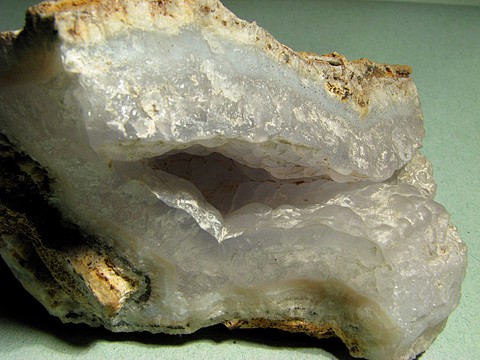
Calcedonio - quarzo alfa microcristallino
II calcedonio Ŕ il nome generico che viene dato al quarzo quando si presenta in masse compatte microcristalline. Tutte le varietÓ sono considerate pietre dure e utilizzate a scopo ornamentale.
Il calcedonio si presenta generalmente in forma di croste o masse concrezionarie, di colore uniforme oppure zonate con striature colorate di varie tonalitÓ. Sono frequenti gli aggregati tondeggianti (mammellonari o botroidali) e nodulari.
La struttura Ŕ costituita da fibre criptocristalline(cristalli invisibili o difficilmente visibili a occhio nudo, ma distinguibili con una lente d' ingrandimento o un microscopio) isorientate e in misura minore da aggregati microgranulari.
La colorazione - molto variabile - dipende dalle impuritÓ presenti nel reticolo cristallino. A seconda della colorazione e dell'aspetto, il calcedonio prende varie denominazioni:
Agata![]() : Ŕ la varietÓ zonata con
strie di colorazione molto variabile (bianco, marrone, blu, nero, verde, rosa
etc...). ╚ il tipico prodotto di precipitazione da soluzione idrotermale in
rocce magmatiche e si associa frequentemente a quarzo cristallino (quarzo
ialino e ametista). Pu˛ presentare inclusioni significative di acqua (enidro).
: Ŕ la varietÓ zonata con
strie di colorazione molto variabile (bianco, marrone, blu, nero, verde, rosa
etc...). ╚ il tipico prodotto di precipitazione da soluzione idrotermale in
rocce magmatiche e si associa frequentemente a quarzo cristallino (quarzo
ialino e ametista). Pu˛ presentare inclusioni significative di acqua (enidro).
Corniola![]() : una varietÓ di calcedonio
con inclusioni di minerali ferrosi da alterazione come limonite o ematite,
caratterizzata da un colore rosso-giallo arancio.
: una varietÓ di calcedonio
con inclusioni di minerali ferrosi da alterazione come limonite o ematite,
caratterizzata da un colore rosso-giallo arancio.
Crisoprasio: un calcedonio traslucido e nickelifero con una colore uniforme tipicamente verde chiaro/giallo-verde.
Diaspro: sono cosý chiamati i calcedoni opachi e di colorazione uniforme. I colori pi¨ comuni sono le tonalitÓ di rosso, viola e verde cupo.
Eliotropio: verde con macchie rosso-arancio dovute a inclusione di idrossidi di ferro.
Onice![]() : opaco o semi-opaco, di
colore uniforme che copre le tonalitÓ rosso-bruno e l'intera gamma di grigi
fino al nero. Se rinvenibile in forma massiva e stratificata prende il nome di
selce: un materiale molto utilizzato dall'uomo nella preistoria per la
preparazione di oggetti affilati e monili.
: opaco o semi-opaco, di
colore uniforme che copre le tonalitÓ rosso-bruno e l'intera gamma di grigi
fino al nero. Se rinvenibile in forma massiva e stratificata prende il nome di
selce: un materiale molto utilizzato dall'uomo nella preistoria per la
preparazione di oggetti affilati e monili.
L'ambiente di formazione comune Ŕ quello filoniano-idrotermale di bassa temperatura (per esempio nella cavitÓ interna dei geodi) e metamorfico. Una genesi secondaria, per via della durezza del quarzo, Ŕ quella nelle rocce sedimentarie detritiche. Talvolta il calcedonio si pu˛ formare anche per trasformazione ricostruttiva dall'opale (che ha una struttura disordinata e parzialmente instabile).
A cut and polished Chalcedony geode
Chalcedony is a cryptocrystalline form of silica, composed of very fine intergrowths of the minerals quartz and moganite. These are both silica minerals, but they differ in that quartz has a trigonal crystal structure, whilst moganite is monoclinic.
Chalcedony has a waxy lustre, and may be semitransparent or translucent. It can assume a wide range of colors, but those most commonly seen are white to gray, grayish-blue or a shade of brown ranging from pale to nearly black.
History
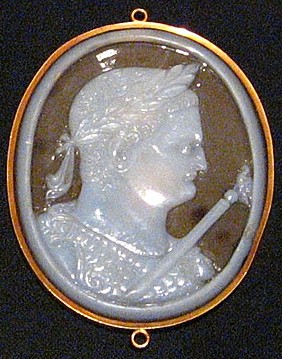
Chalcedony cameo of Titus head, 2nd Century AD
As early as the Bronze Age chalcedony was in use in the Mediterranean region; for example, on Minoan Crete at the Palace of Knossos chalcedony seals have been recovered dating to circa 1800 BC. People living along the Central Asian trade routes used various forms of chalcedony, including carnelian, to carve intaglios, ring bezels (the upper faceted portion of a gem projecting from the ring setting), and beads that show strong Graeco-Roman influence. Fine examples of first century objects made from chalcedony, possibly Kushan, were found in recent years at Tillya-tepe in north-western Afghanistan. Hot wax would not stick to it so it was often used to make seal impressions. The term chalcedony is derived from the name of the ancient Greek town Chalkedon in Asia Minor, in modern English usually spelled Chalcedon, today the Kadik÷y district of Istanbul.
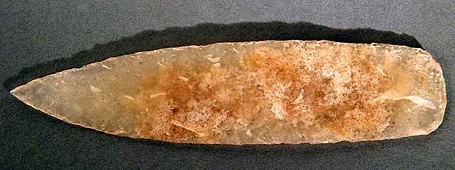
Chalcedony knife, AD 1000-1200
Varieties
Chalcedony occurs in a wide range of varieties. Many semi-precious gemstones are in fact forms of chalcedony. The more notable varieties of chalcedony are as follows:
Agate
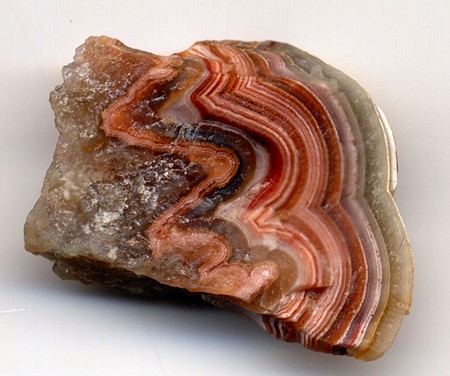
Agate![]() is a
variety of chalcedony with concentric banding. Agate with black and white
banding is known as onyx.
is a
variety of chalcedony with concentric banding. Agate with black and white
banding is known as onyx.
Carnelian
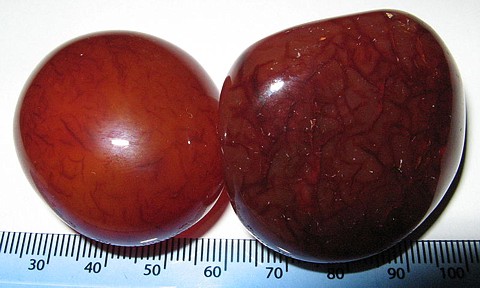
Carnelian![]() . (also
spelt cornelian) is a clear-to-translucent reddish-brown variety of chalcedony.
Its shade may vary from a pale orange, to an intense almost-black coloration.
Similar to carnelian is sard
. (also
spelt cornelian) is a clear-to-translucent reddish-brown variety of chalcedony.
Its shade may vary from a pale orange, to an intense almost-black coloration.
Similar to carnelian is sard![]() , which
is generally harder and darker.
, which
is generally harder and darker.
Chrysoprase
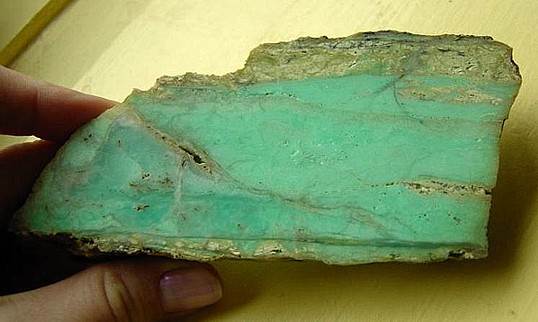
Chrysoprase or chrysophrase is a gemstone variety of chalcedony (a cryptocrystalline form of silica) that contains small quantities of nickel. Its color is normally apple-green, but varies to deep green. The darker varieties of chrysoprase are also referred to as prase. (However, the term prase is also used to describe green quartz, and to a certain extent is a color-descriptor, rather than a rigorously defined mineral variety.)
Chrysoprase is cryptocrystalline, which means that it is composed of crystals so fine that they cannot be seen as distinct particles under normal magnification. This sets it apart from rock crystal, amethyst, citrine, and the other varieties of crystalline quartz which are basically transparent and formed from easily recognized six-sided crystals. Other members of the cryptocrystalline silica family include agate, carnelian, and onyx. Unlike many non-transparent silica minerals, it is the color of chrysoprase, rather than any pattern of markings, that makes it desirable. The word chrysoprase comes from the Greek chrysos meaning 'gold' and prason, meaning 'leek'.
Unlike emerald which owes its green color to the presence of chromium, the color of chrysoprase is due to trace amounts of nickel in the structure. The nickel reportedly occurs as platelets of the talc-like mineral willemsite. Chrysoprase results from the deep weathering or lateritization of nickeliferous serpentinites or other ultramafic ophiolite rocks. In the Australian deposits, chrysoprase occurs as veins and nodules with brown goethite and other iron oxides in the magnesite-rich saprolite below an iron and silica cap.
As with all forms of chalcedony, chrysoprase has a hardness of 6 - 7 on the Mohs hardness scale and a conchoidal fracture like flint. The best known sources of chrysoprase are Queensland, Western Australia, Germany, Poland, Russia, Arizona, California, and Brazil.
Heliotrope or bloodstone
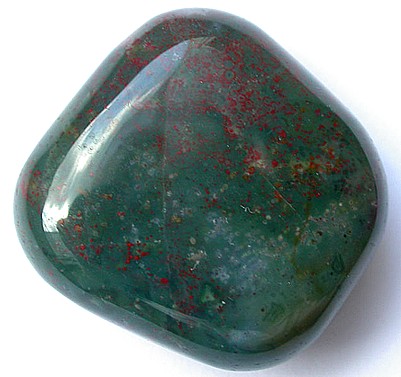
The mineral heliotrope, also known as bloodstone, is a form of chalcedony, which is a cryptocrystalline quartz. The "classic" bloodstone is green jasper with red inclusions of iron oxide (red jasper). Sometimes yellow and/or other colors of jasper are also present, but these multi-colored gemstones are usually called "fancy jasper".
The red inclusions are supposed to resemble spots of blood; hence the name "bloodstone". The name "heliotrope" (from Greek helios, Sun, trepein, to turn) derives from various ancient notions about the manner in which the mineral reflects light. The primary source of the stone is India. It is also found in Brazil, China, Australia, and the United States.
Bloodstone is the original birthstone for March. Today, bloodstone, jasper and aquamarine are all considered the gemstones for March. It is said that bloodstone creates harmony and balance, and promotes self-esteem. In the Middle Ages the red spots were thought to be the blood of Jesus, and the stone was believed to have miraculous powers, including making its wearer invisible. Boccaccio writes about it in his Decameron (VIII, 3).
Moss agate
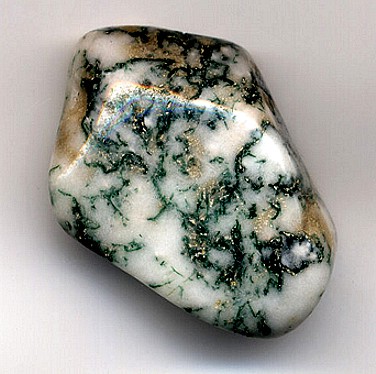
Moss agate (also called mocha stone) is a semi-precious gemstone formed from silicon dioxide. This mineral is commonly found in limestone and granite. It is a form of agate which includes minerals of a green colour embedded in the chalcedony, forming filaments and other patterns suggestive of moss. It also sometimes resembles blue-cheese. The field is a clear or milky-white quartz, and the included minerals are mainly oxides of manganese or iron. Moss agate is of the white variety with green inclusions that resemble moss. It occurs in many locations. The colors are formed due to trace amounts of metal present as an impurity, such as chrome or iron. The metals can make different colors depending on their valence. Despite its name, moss agate does not contain organic matter and is usually formed from weathered volcanic rocks.
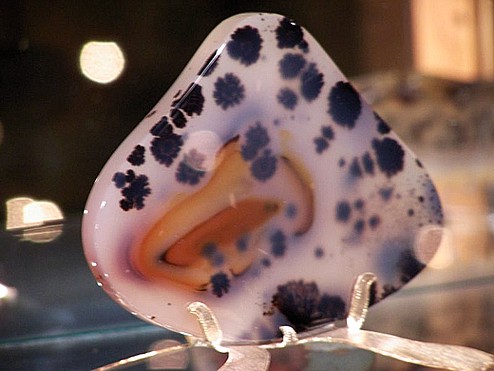
Montana moss agate
Montana moss agate is an agate found in the alluvial gravels of the Yellowstone River and its tributaries between Sidney and Billings, Montana. The agate originally was formed in the Yellowstone National Park area of Wyoming as a result of volcanic activity. In Montana moss agate the red color is the result of iron oxide, the black is there result of manganese oxide.
Structure
Chalcedony was once regarded to be a fibrous variety of cryptocrystalline quartz. More recently however, it has been shown to also contain a monoclinic polymorph of quartz, known as moganite. The fraction, by mass, of moganite within a typical chalcedony sample may vary from less than 5% to over 20%. The existence of moganite was once regarded as dubious, but it is now officially recognised by the International Mineralogical Association.
Solubility
Chalcedony is more soluble than quartz under low-temperature conditions, despite the two minerals being chemically identical. This is thought to be due to the fact that chalcedony is extremely finely grained (cryptocrystalline), and so has a very high surface area to volume ratio. It has also been suggested that the higher solubility is due to the moganite component.